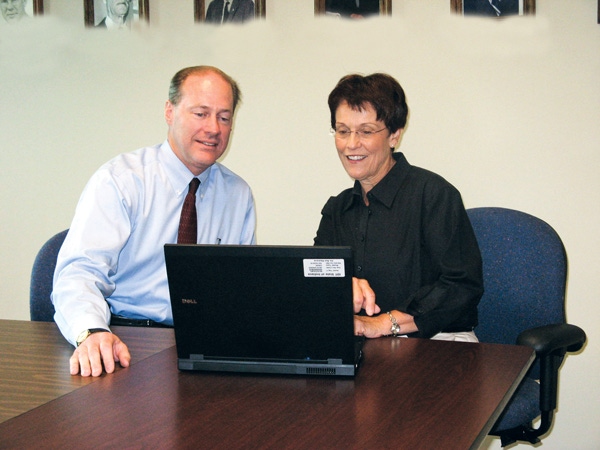Enhancing Disease Surveillance
Whether tracking reported cases of porcine reproductive and respiratory syndrome (PRRS) or quickly addressing an animal health emergency, Indiana Board of Animal Health (BOAH) officials are ready to respond.

Whether tracking reported cases of porcine reproductive and respiratory syndrome (PRRS) or quickly addressing an animal health emergency, Indiana Board of Animal Health (BOAH) officials are ready to respond.
Located at the crossroads of America, Indiana is the smallest state west of the Appalachian Mountains, boasting an extremely wide diversity of animal production, according to Marianne Ash, DVM, director of biosecurity for BOAH.
Indiana imports nearly three million pigs from 30 states and five Canadian provinces for finishing and slaughter each year.
This places a large burden on staff to monitor swine health, in particular the looming threat of PRRS, but also foreign animal disease threats, such as classical swine fever and foot-and-mouth disease, she says.
Building a Program
In response to these types of concerns, BOAH officials wanted to offer producers protection without excessive regulations.
Five years ago, Indiana developed a state rule that requires registration of all premises associated with farm animals. “Basically, if you are buying, selling or exhibiting animals — any movement off the property — that site needs to be registered with the state,” Ash explains.
“We basically register the dirt, so if it is a site that has livestock on it, we need to know where that site is. We have had great participation and support from the commodity organizations in the state,” says Bret Marsh, DVM, state veterinarian. Wisconsin is the only other state with a mandatory premises registration program.
For example, the Hoosier Beef Congress, the largest single-state youth cattle show in the United States, has required premises registration the last four years, Marsh says. For the last two years, all animals in exhibition were required to carry electronic identification (ID) ear tags. Also, any animals exhibited at the Indiana State Fair must have premises ID, issued by the state of origin. Cattle owners from states without their own program can obtain a premises ID through the national (USDA) allocator.
Last year, there was a foreign animal disease investigation in the swine barn during the Indiana State Fair because a pig had vesicles at the coronary bands on all four legs, he recalls. A team of state and federal veterinarians were dispatched to the site, and samples were taken and submitted to the diagnostic laboratory at Purdue University. By early the next morning, a negative diagnosis was delivered.
Marsh says having a premises registration program in place assured officials of the exact origin of the animals, providing a great tool for traceback in case any pigs would have gone into commerce after the fair.
“It is a mandatory program that producers have picked up on. They have seen through our bovine tuberculosis outbreak traceback effort, and the foreign animal disease investigation at the state fair (both events occurring this past year), that this is a great tool for our state,” he observes.
In fact, for enhanced traceback capabilities, all of the beef exhibits at 92 county fairs in Indiana this year are being electronically identified. A simple wand reader is used to scan ear tags at weigh-ins, Marsh says.
BOAH recently sent letters to farm sites on the premises registration program list to update operational status. Registration is free and signup only takes minutes at www.boah.in.gov.
Hog Industry Buy-In
“We have a growing and developing swine industry in the state, and we are interested in knowing who’s out there,” Marsh says. “Producers who want to build can use this premises registration tool to find out if there are other operations in the area. We don’t tell them whether we think that a site is a good choice or not, but we can provide them with the information to help make that choice.”
Unlike the days of pseudorabies eradication, there is no regulatory program for PRRS, no restrictions on movement and no testing requirements.
“This is kind of a unique role for the Board of Animal Health as a regulatory agency — we are not regulating PRRS. But we do have some tools that we can use to assist the industry as it continues to grow and change. We have premises registration, and we are collecting some diagnostic data on what PRRS information comes through diagnostic labs,” he continues.
BOAH’s attempts to stay relevant come as the swine industry becomes more dense and there is a stronger need for biosecurity. The Hoosier State is now processing a record 8.5 million hogs a year, nearly double the number of a few years ago.
Mapping for PRRS
Since data started being stored in the U.S. Animal Health Emergency Response and Diagnostic System (USAHERDS) database at BOAH in 2006, Ash has led staff in producing maps that point out the locations of PRRS-infected herds. The maps do not identify specific locations of operations or list producers by name, says Denise Derrer, public information director for BOAH.
Using USAHERDS and premises registration, Ash has begun compiling historical data about PRRS breaks in Indiana, which is expected to be useful in the states’ handful of PRRS regional control projects.
USAHERDS is beginning to track the various strains of PRRS as they break and/or move in the state, based on diagnostic lab reports.
“We can share that information, down to the county level, with producers so they know what is happening in their communities,” Derrer says. The result is producers are beginning to ask BOAH for maps to make siting decisions.
Using the USAHERDS database and premises ID information, a map can be quickly developed to pinpoint problem areas and engage staff to respond.
With the regional PRRS control projects, BOAH’s tools have helped characterize and define project areas to understand the geography and demographics of the project area.
“I have been told by many who support these PRRS projects across the nation that this process usually takes a year or two — and we can do this in a day,” Ash says.
Indiana has all the data necessary to forge ahead with projects at the first producer meeting — and that ability has engaged producers right from the start, Marsh says.
BOAH assists the PRRS projects in providing general data management support and mapping of farm locations, animal movements, test data and Production Animal Disease Risk Assessment Program assessments
(biosecurity risks for infection), she says.
PRRS data can be interpolated to help one look at type of hog operation and disease status, protecting producer anonymity and illustrating the spatial patterns of disease in regions of the state, Ash says. That data has helped clear up PRRS from some regions and pointed out the failure of cleanup efforts in other areas.
Marsh is hopeful that producers will go a step beyond just registering their premises to provide more specific data on their hog operations that will help BOAH support growth and development while limiting the impact of PRRS.
In the spirit of cooperation, not regulation, BOAH also convened a 42-member advisory committee to dialogue about how BOAH could help in a non-regulatory way to further efforts to control PRRS as well as desensitize the issue. A scientific subcommittee comprised of veterinarians advises on developing recommendations, Marsh says.
Online Permitting
Ash says BOAH is working on securing funds so that producers and their veterinarians can utilize an online permitting system. This information could be shared with the 12 states using USAHERDS, as the states collectively work to enhance disease control efforts, while developing a customized system that meets the animal health needs of each state.
This computerized system would facilitate coordination of testing requirements and movements based on health status for regulated diseases, Ash says.
Combined with data collected from Indiana’s premises registration requirement (37,000 sites registered), USAHERDS data can map “spots on the ground” from infected farms, slaughter facilities and feral swine to nuclear power plants near potentially at-risk farms to be contacted quickly in the event of an emergency, she says.
“This also means that you can determine the proximity of one farm to another, so that if you’ve got an infected farm, you can identify the proximity of the farms that might be at risk — and the data is Web accessible,” Ash declares.
Web access has enabled BOAH to take staff out of the central office in Indianapolis and scatter them across the state to manage disease programs or handle an emergency situation, while retaining ready access to an individual’s information from a secure site, she points out.
“This online permitting system will be not only for dealing with the import permits that we currently get, and to make it more efficient to get them, but also to have a tool in place to deal with the massive requirement that would exist to track intrastate animal movement in an emergency,” Ash says.
Electronic Health Papers
The value of premises identification has been extended through electronic ID for electronic health certificates. An estimated 35-40% of swine leaving the state are using that technology, providing real-time data transfer of health information, Marsh reports.
The challenge is to get 40% or more of the hogs entering the state to use these certificates as well, he says.
Future non-regulatory endeavors for BOAH beyond disease surveillance could include food safety and residue avoidance, Marsh says.
About the Author(s)
You May Also Like





